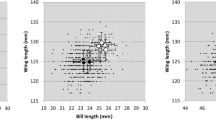Abstract
By attaching a reflective strip to the thorax, we documented with video recordings in a wind tunnel the spatial orientation of male gypsy moths, Lymantria dispar, as they flew along a plume of sex pheromone. In wind speeds of 61, 122, and 183 cm s−1, moths flew very similar tracks along a pheromone plume. Moths aimed their thrust closer to upwind in increasing wind speeds using a roll maneuver. As a result, the orientation of their visual flow field, represented by the slip angle (the angular distance between the direction of flight and the longitudinal body axis), remained relatively constant. We propose that directional control during self-steered zigzagging is achieved by rolling, thereby maintaining a set slip angle. Following a roll at the apex of a turn that aligns the moth with its preferred slip angle, a moth banks toward a cross wind leg. By banking moths may maintain a stable image flow at oblique angles to their longitudinal body axis.
Similar content being viewed by others
Author information
Authors and Affiliations
Additional information
Accepted: 16 July 1998
Rights and permissions
About this article
Cite this article
Zanen, P., Cardé, R. Directional control by male gypsy moths of upwind flight along a pheromone plume in three wind speeds. J Comp Physiol A 184, 21–35 (1999). https://doi.org/10.1007/s003590050303
Issue Date:
DOI: https://doi.org/10.1007/s003590050303




